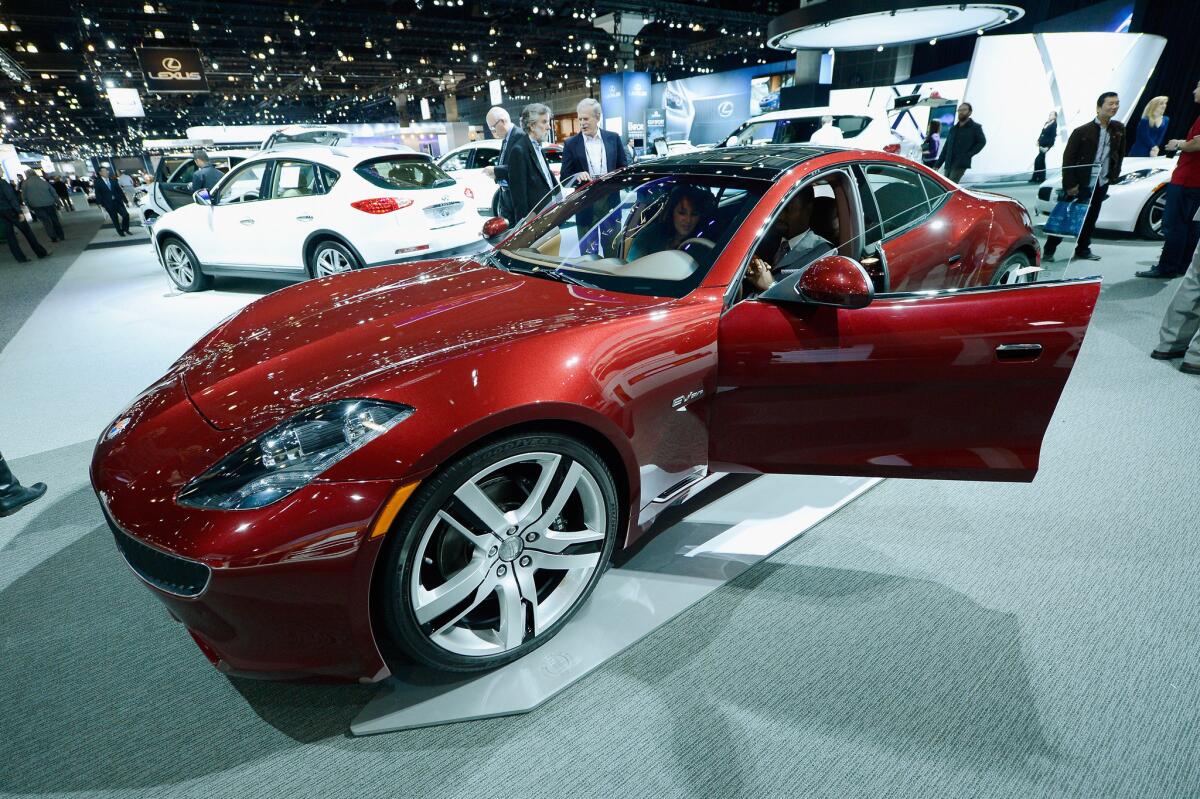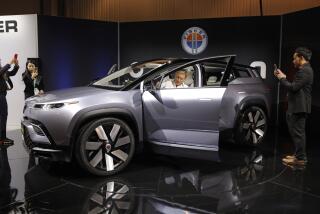Saturday Drive: 2012 Fisker Karma

A company buying the assets of Fisker Automotive hopes to relaunch sales of the Karma sports car.
The car: Fisker Karma
The power: 403 total horsepower coming from two 201.5-horsepower (150 kW) AC motors, mounted just above the rear wheels.
Torque is in the neighborhood of monstrous, with 981 pound-feet available at 0 RPM. That figure sounds like enough to collapse a lung from the driver’s seat, but consider this car weighs 5,300 pounds, or about as much as a Chevy Tahoe SUV.
The speed: 0-60 miles per hour in 5.9 seconds in Sport mode using the gas engine to power the generator, battery and electric motors, or 7.5 seconds in purely electric mode.
The bragging rights: The world’s first luxury electric vehicle with extended range.
The price: The Karma starts at $95,000 and goes to $108,900 before tax incentives. The model we tested and you see here is the EcoChic, which sits at the high end of that pricing spectrum.
The details: Powering the two electric motors, which power the rear wheels, is a 180 kW, lithium-ion, rechargable battery. It runs the length of the car’s interior, slotted between the left and right seats, covered by a large center console and armrests. On electric power alone, the battery gives the Karma a range of 30-50 miles. Power is transferred to the rear wheels via a single-speed transmission.
Also charging that battery is a generator powered by a 260-horsepower, 2.0-liter turbocharged, direct-injected, four-cylinder engine (an Ecotec unit made by GM). Ignore that horsepower figure though; it’s provided only to indicate the engine’s strength and has no immediate effect on the power of the Karma. The gas engine/generator combination gives you another 250 miles of range, for a total range of 280-300 miles.
To be clear: the gas engine is not powering the wheels. Ever. Nope, not even then. It runs to power a generator, which sends power through the battery, which then powers the electric motors. In theory, the Karma could run on no gasoline whatsoever.
The car runs in one of two modes, Sport and Stealth, which the driver selects using what amounts to a paddle shifter on the left side of the steering wheel. Stealth is electric-only mode, with power coming only from the battery. Toggle into Sport mode, and the engine fires up to join the party.
The drive: For starters, this is more of a first look at the driving dynamics than the nuances of charging it and its range. For that, look for our full review in a few months. Or call Leo, if he’s in town. He’s an owner and an investor.
The initial takeaway is that this is a big, dramatic, heavy car. Squeezing a battery roughly the size and shape of a real-life Gumby down the center of the interior helps mitigate the effects of its mass, but it’s still there. Especially when that battery weighs 605 pounds.
Though 403 total horsepower may sound like a lot, you’re never overwhelmed by the Karma’s output because the car needs all of it to keep it moving. The car doesn’t squirt off the line like you might expect an electric car to.
Similarly, when you’re in traffic or on twisty roads, the car doesn’t so much dart as it does move with purpose. Think of a linebacker in a three-piece suit. But it handles its mass very well and stays firmly planted through hard cornering.
The suspension is well-tuned to the car’s weight. Body roll is controlled and the ride is sporty, but comfortable. The electro-hydraulic steering is nicely weighted and relays some feedback from the road but it could be more direct. The brakes are plenty firm, yet Fisker has done a nice job of modulating how touchy they can be. Some regenerative brake systems on more mainstream, mass-produced cars get a bit too eager.
Drivers who really want to recharge the car’s batteries have a pair of Hill modes that progressively increase the amount of energy captured. Hill 1 provides moderate resistance as you descend, while Hill 2 dramatically slows down the car.
Fisker says to think of these settings as alternatives to braking during spirited driving. Rather than using the brakes to slow a car just before and also during a turn (known as trail braking), drivers can switch the car into Hill 1 or 2 (actuated by a paddle shifter on the right side of the steering wheel) and slow the car this way.
Though it sounds like a gimmick, the level of resistance Hill 2 puts on the car is severe enough that it does act as a useful braking technique as you carve up the canyons.
Constant throughout a variety of driving conditions are an interesting mix of sounds made by this Fisker. It’s not noisy by any means, but there’s always something to listen to.
At cruising speed the cabin is fairly quiet. Road and wind noise are minimal and there’s the faint whine from the electric motors that you might know from your golf cart. If you have the Karma in Sport mode, the engine also runs quietly.
Push hard on the gas, especially uphill, and the engine gets more intrusive, throwing off a strained groan that can’t be mitigated by upshifting, since the car’s transmission has only one speed. Despite the excellent engineering that went into this car, there’s just no hiding the noise from the 2.0-liter engine when the driver is pushing the car. The disconnect between that noise and the car’s overall poise and aesthetic is a bit jarring. Imagine if Halle Barry opened her mouth and sounded like Ben Stein.
At idle and low, pedestrian-hitting speeds, the Karma emits two distinct sounds. The first is that ever-present electric-car whine. The second is an odd mechanical buzzing not unlike a Pod Racer tiny Anakin Skywalker drove in Star Wars. This is to warn those around you that the car is approaching and happens up to 25 miles an hour.
But if my experience was any indication, people will likely notice you’re coming along before they hear Anakin. That this car has immense road presence, both literal and figurative, is no accident, according to company co-founder and CEO Henrik Fisker.
Before starting the company in 2007, Fisker was the man behind the Aston Martin DB9 and V8 Vantage and BMW’s Z8, so it’s safe to say he knows his way around a sketch pad.
Fisker (the man) said the Karma’s design was his top priority, with a commitment to the environmental aspect of motoring a close second. Central to Fisker’s design of the Karma was that he wanted the car to be the best designed car in its class, to own the road.
In my brief day with the car, plenty of road ownership occurred. This, in a town where six-figure cars just litter the roads. It’s an epidemic really.
The Karma’s 196.7-inch length is just over an inch longer than Porsche’s Panamera, though it’s slightly narrower and lower than the Porsche.
Consider it the thinking man’s Panamera. The Karma absolutely wallops the big Porsche in the looks department, and some of the many looks we received while driving this car through Hollywood, Malibu and the freeways were from drivers in Panameras who clearly saw their vehicle’s cache as the coupe-like sedan de jour gravely threatened.
The Karma cuts a dramatic figure with a small greenhouse (the glass portion of the car) flanked by rising fenders over the massive 22-inch front and rear wheels. Despite the tidy proportions, seating space inside isn’t compromised, though rear visibility is. Trunk space is downright small.
Inside, the Karma favors minimalism, with physical buttons only where regulated by law (turn-signal stalks, power mirror switches, hazard lights, door locks). The center console is dominated by a 10.2-inch touchscreen that controls nearly everything else on the car.
The screen features haptic feedback (it will buzz slightly when and where you touch the screen) and learning your way through the car’s functions takes more than a little time because the system favors digital aesthetics over rote input. The system was also slow to respond to commands (something Fisker says its addressing) and the screen put off a lot of glare in the L.A. sun.
Using a screen like this serves an economical function for Fisker though. Designing and manufacturing the switchgear one might expect in a traditional car costs several piles of money (that’s the scientific term). When done on the scale of major automakers that can use similar components throughout their vehicle lineup, the cost is reduced.
When you’re Fisker, that potential cost can be a dealbreaker. Using a screen requires minimal engineering and manufacturing. Fisker can also update the system (which it says it plans to do) throughout the lifespan of the Karma without major retooling or cost.
If the name Fisker rings a bell, it’s because you’ve likely heard it in the news recently. Early last week, the U.S. Department of Energy put on hold $336 million in loans because Fisker had missed deadlines for bringing the Karma to market. That remaining money had been earmarked by Fisker to be used to produce the company’s second electric vehicle, the smaller Nina.
To date, the company has received $193 million in federal loans, most of which was used to develop the Karma. Fisker initially claimed it could sell some 7,000 Karmas in 2011 alone. Call it an excess of optimism or hubris, but the company now says (as of this week) that it has produced 1,500 Karmas and 20-25 more are made each day. Several hundred are in customers’ hands. Fisker (the man) insists that by the end of the year his company will be cash-flow positive based on Karma sales alone.
Where those cars are made has also raised a bit of consternation in some circles. Fisker has contracted a company called Valmet to build the Karma in Uusikaupunki, Finland. Porsche owners may know Uusikaupunki because that’s where Porsche’s Boxster and Cayman are made. It’s also what a Nobel physicist said three times fast before she was turned into Snooki.
Regardless of where one’s political persuasions fall, to drive the Fisker Karma is to drive a real vehicle made by a real automaker. Starting a new car company today is akin to starting an NFL football franchise one player at a time. In this case, it would seem Fisker has started off with a young Joe Namath: talented, good-looking and eager for attention.







